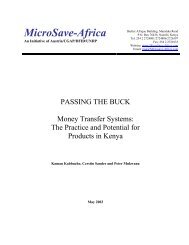You also want an ePaper? Increase the reach of your titles
YUMPU automatically turns print PDFs into web optimized ePapers that Google loves.
In 2006, <strong>DAI</strong> hosted<br />
a party for the Global<br />
Development Alliance<br />
(GDA). <strong>DAI</strong> Senior<br />
Vice President for<br />
Project Management<br />
Rob Dressen stands<br />
at left. Among many<br />
other things, GDA<br />
worked with <strong>DAI</strong> and<br />
others on HIV/AIDS<br />
issues.<br />
90<br />
A Changing Landscape<br />
For the first half <strong>of</strong> <strong>DAI</strong>’s history, the landscape<br />
<strong>of</strong> U.S. foreign aid remained a familiar one.<br />
USAID had its changing priorities, but almost<br />
alone it had been the chief provider <strong>of</strong> U.S.<br />
foreign assistance. That changed in the latter<br />
part <strong>of</strong> <strong>DAI</strong>’s history, as the military, the State<br />
Department, and newly created agencies took<br />
more prominent roles in overseas development.<br />
One <strong>of</strong> these new agencies was the Millennium<br />
Challenge Corporation, established by<br />
Congress in 2004 to disburse funds to countries<br />
that seemed to have high potential for<br />
successful economic development. Another<br />
was the President’s Emergency Plan for Aids<br />
Relief (PEPFAR), intended to combat HIV/AIDS,<br />
primarily in Africa.<br />
USAID was itself changing dramatically. At the<br />
outset <strong>of</strong> the Bush administration, the agency<br />
formulated its own response to growing calls to<br />
bring free-market forces into play in the realm <strong>of</strong><br />
foreign aid. One result was the Global Development<br />
Alliance (GDA), created in 2001 to facilitate<br />
public-private cooperative efforts. Such efforts<br />
started by identifying development opportunities<br />
and assigning seed money. GDA then enlisted<br />
corporate and other private sector partners to<br />
pursue collaborative solutions. In 2006, <strong>DAI</strong> won<br />
an IQC to provide a broad range <strong>of</strong> implementation<br />
services for GDA. Led by Kristi Ragan,<br />
the GDA team established a presence at both<br />
GDA’s <strong>of</strong>fices in Washington and <strong>DAI</strong>’s headquarters<br />
in Bethesda. Among the team’s tasks<br />
were to involve the Mars Corporation in Haitian<br />
hillside farming, help Unocal and ConocoPhillips<br />
fund tsunami relief in Indonesia, and coordinate<br />
efforts by the Government <strong>of</strong> Lesotho and major<br />
U.S. clothing retailers to fight HIV/AIDS in that<br />
country’s garment industry. By mid-2009, <strong>DAI</strong><br />
had leveraged $3 million in program funds into<br />
$17 million in public-private partnerships.<br />
This shifting landscape <strong>of</strong> development meant<br />
tougher going for contractors. As the cost <strong>of</strong><br />
competing for and administering contracts<br />
steadily increased, start-ups faced ever higher<br />
barriers to entry, and even many older, more<br />
established firms were regularly relegated to<br />
subcontractor status. Just a few big contractors,<br />
<strong>DAI</strong> among them, tended to take the lead<br />
in prime contracting. With industry leadership,<br />
however, came new hazards, including the<br />
chance that in the absence <strong>of</strong> a compelling <strong>DAI</strong>



